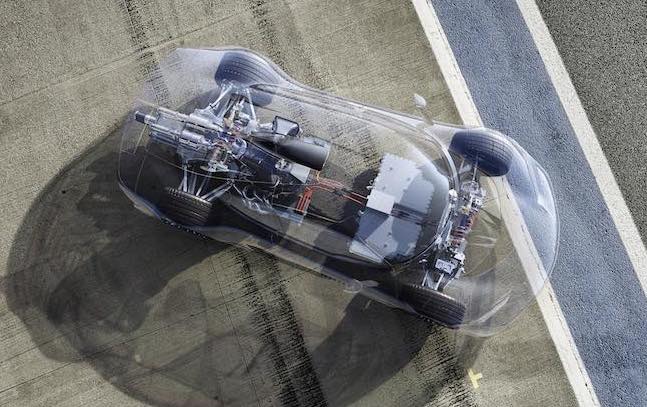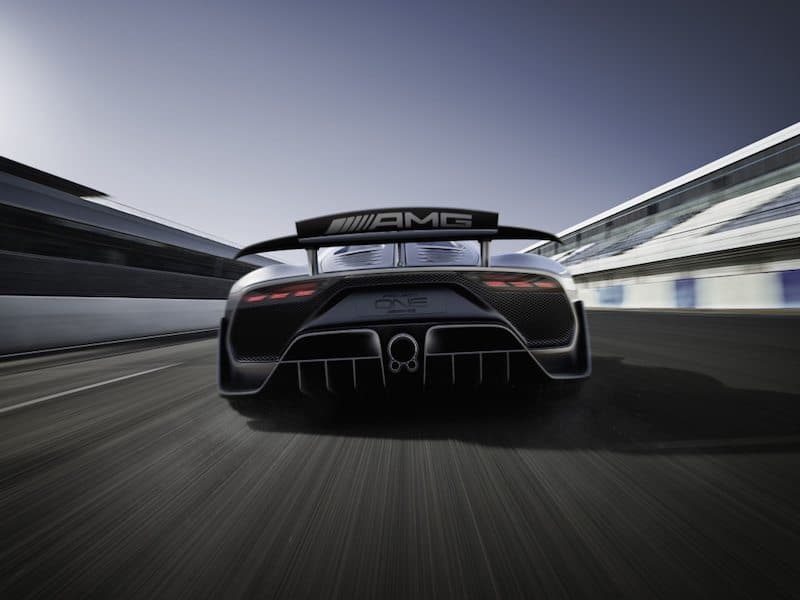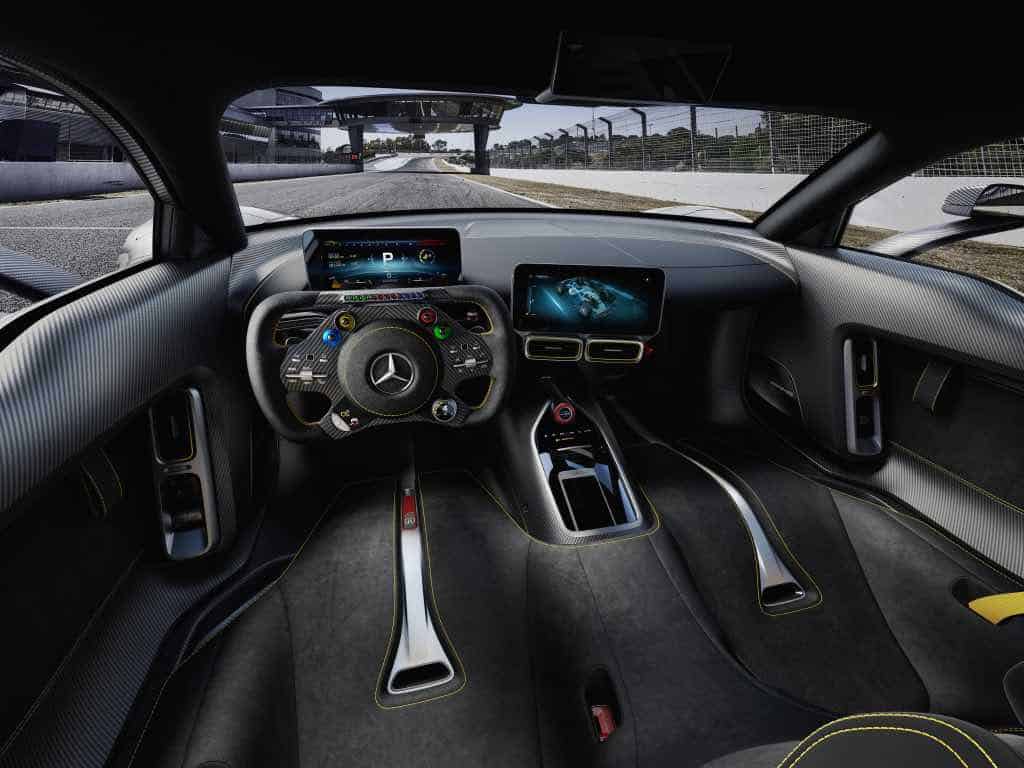
30d Specifications
Engine Size: 1.6 Litre V6 Hybrid
Max. Power: 746 kW / 1000 hp
Max. Torque: tba
Fuel Type: Petrol
Fuel Consumption: tba
Transmission: 8 Speed
Acceleration 0-200 km/h: <6 Secs
The first thing you need to know is that it is packed with Formula 1 tech. And I don’t mean that familiar, albeit true, platitude about the ‘motorsport experience translated to the road’. This is literally packed with F1 tech, only some of which will be described below. Mercedes says that the car was developed by Mercedes-AMG in cooperation with the F1 people from Mercedes-AMG High Performance Powertrains and Mercedes-AMG Petronas Motorsport. These guys don’t give advice about improving aircon systems and fuel efficiency in the city.
The most notable F1 feature is the tech regarding the powertrain. As mentioned, the engine is a turbocharged 1.6l V6 aided by a hybrid technology. The mixture provides the car with more than 1,000 horsepower and blatantly obvious racetrack abilities, while still being street legal. I have a feeling they were aiming for some of that McLaren F1 hype and even the body styling mimics this to some extent. Be that true or not, the Project One is the first ever road car with so much F1 tech.



The Powertrain
The turbocharged engine is aided by 4 electric motors. The four motors do NOT each power one wheel as one might think. Two motors power the front wheels, one is connected to the crankshaft and one is located within the turbocharger, working to eliminate any sign of turbo lag.
The engine is taken directly from the Mercedes-AMG Petronas Formula 1 racing car and it packs four camshafts and direct fuel injection. Efficiency was paramount so the engineers decided to use pneumatic valve springs instead of the standard mechanical ones. This greatly increased the engine speeds which can go to 11,000 revs.
Many of you will notice that this is virtually unheard of in road cars, but also way under what the F1 cars engines reach. So, is it the F1 engine?
Yes! The reduction of the top revs compared to the F1 is there for two reasons. First of all, longevity of the road car engines and F1 engines is vastly different. The engine in the Project One is supposed to last longer than a few races. Secondly, despite the stunning performance figures described below, this car uses standard Super Plus petrol that you can easily buy and not racing fuel.
But that’s only the internal combustion unit. There are four electric motors more. The two electric motors that power the front wheels go up to 50,000 rotor revs. Now, admittedly, current electric motors rev higher than internal combustion engines, but a really top notch one goes up to 20,000 rotor revs. Is Mercedes taking over the electric industry as well? These motors are independent and this allows torque vectoring. The all electric drive is possible and limited to 25 km.
Another electric motor is located in the turbocharger. Unlike most other turbos, the side which compresses the air and the side which is spooled by the exhaust gas are separated from one another so that they could be placed in the best possible positions for their respective purposes. They are connected by a shaft and the third electric motor is connected to the shaft which pushes the compressor side of the turbocharger and goes all the way up to 100,000 revs.
This means that one major downside of the turbocharger – the infamous turbo lag – is non-existent. The Project One responds faster than a naturally aspirated V8.
So, where is the last electric motor? It is connected to the crankshaft to ensure that it also spins effortlessly and instantly. A part of the power for this motor comes from a system within the turbo which utilizes the energy from the exhaust and sends it either to the crankshaft motor or to a lithium-ion battery.
If this is all too techy for you, in short, it means that various solutions in the powertrain work to eliminate the weakest spots in the system, ensuring easier, more efficient operation and reduction of any hampering forces. Moreover, the systems use much of the usually wasted energy and recycle it.

The Figures
All this tech translates to some pretty stunning figures. The 1.6 V6 and four electric motors provide the power rating that has not been specified exactly, but does exceed 740 kW (1,000 hp). The front wheels get 120 kW each and the rear ones more than 500 kW for the rear ones.
The acceleration to 100 has not been stated, but it takes UNDER 6 seconds to reach 200 km/h. For comparison purposes, the Chiron takes 6.5 seconds and the P1 in 6.8.
The top speed has not been stated either, except that it is higher than 350 km/h.
The gearbox is completely new, it has 8 speeds and it is either completely automatic or controlled by paddle shifters.
Suspension
The suspension is multi-link, but it also packs several innovative solutions. Contrary to the top car trends, the Project One does not have any form of air or hydraulic suspension, but it packs adjustable coilovers. Of course, the handling and suspension systems are aided by loads of hi-tech safety and performance solutions. For example, ESP has three modes, as is common with AMG cars and the top one is dedicated to enclosed tracks usage.
Wheels and brakes
Yes, even the wheels are new and dedicated. They are made of forged aluminium and they have a semi-cover made of carbon fiber. It is not just for show, but it actually noticeably reduces drag. Each spoke of the 10 on each wheel has three ventilation slots which helps brakes get rid of the unwanted heat. The front wheels are wrapped in 19” and the rear ones in 20” tyres specially made by Michelin.
The carbon-ceramic brakes have also enjoyed weight reduction, which greatly improved agility as well as durability.

The looks
Honestly, all it should have done was not look as bad as the first Fiat Multipla. With such high tech and performance features, the not many people should complain whatever the design.
However, the car looks pretty good. The mid-engine layout dictated the overall shape, but the muscular design is just damn amazing. It also bears some resemblance to the McLaren F1 and this can only be a good thing. The F1 has been a benchmark in performance for decades and the Project One seems destined to take over.
The front apron is damn huge. Air intakes are prominent and spread to the full width of the car, combining the aggressive sharpness with the elegantly flowing body lines. The roof also has an intake which develops into probably the most conspicuous design feature of this car – the rear fin. Once again, the fin is not there just to look strange, but it improves lateral stability. Most of the design solutions have the practical purpose of controlling the air, either by sending it to where it is needed (engine or cooling), or by improving stability.
The interior is pretty spartan. It is basically a Formula 1 shape with enough room to fit two people in. Mercedes says that nothing has been added to the interior in order to improve the looks – rather it all has some practical purpose. Just look at the steering wheel. It is the best example of the philosophy for the interior – practicality and efficiency.
Aside from various ways to adjust your driving position, there are other perks to help with everyday driving, but they are kept to the necessary minimum. For example, the car has small storage spaces behind the seats, air conditioning system, power windows, COMAND infotainment and rearview mirror camera.
Mercedes says that this is ‘the future of driving performance’ and judging by the information given, this could well be true. Cars such as the P1, LaFerrari, Chiron and 918 have brought the familiar road car tech to the max. However, the Project One is different. It brings completely new technologies, so far reserved for the very top of the racing world. The fact that you literally have a Formula 1 engine in a street legal car should be enough to explain what a huge leap the Project One is for the entire industry.









